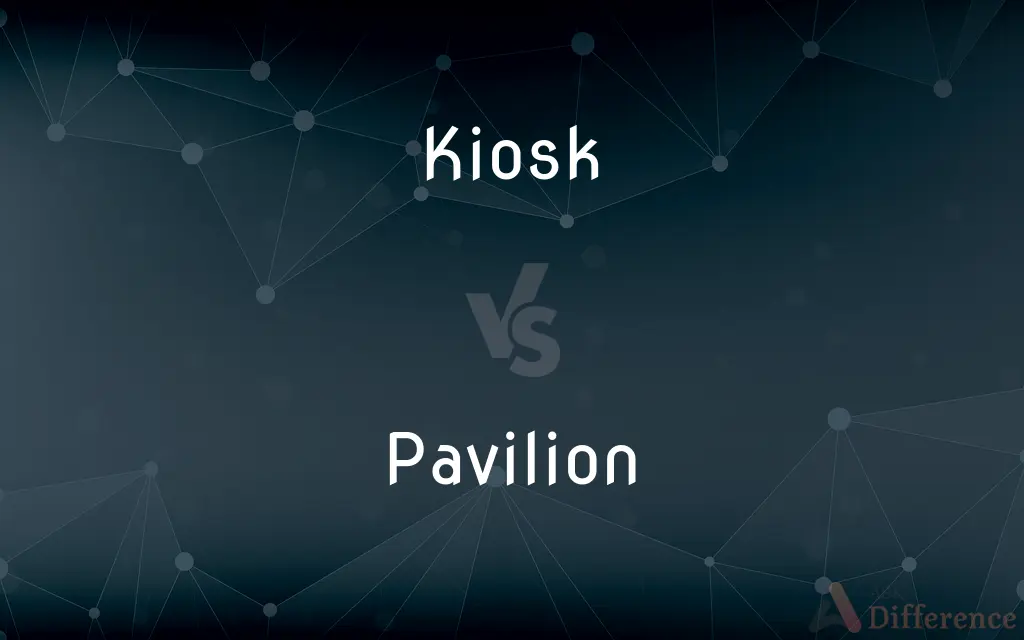Kiosk vs. Pavilion — What's the Difference?
By Maham Liaqat & Urooj Arif — Updated on April 19, 2024
A kiosk is a small, often temporary structure used for vending or information services; a pavilion is a larger, often permanent, open building used for leisure or exhibitions.

Difference Between Kiosk and Pavilion
Table of Contents
ADVERTISEMENT
Key Differences
Kiosks are typically small, enclosed units located in public spaces like malls, airports, or on streets. They serve specific functions such as selling food, newspapers, or providing tourist information. Whereas pavilions are larger structures, commonly found in parks, exhibition areas, or as standalone attractions, designed to host people for events, shelter from weather, or as focal points in a landscape.
The design of a kiosk is usually compact and focused on functionality, maximizing limited space for sales or information dissemination. On the other hand, pavilions are more architectural in nature, often designed to be aesthetically pleasing and accommodating for gatherings, offering extensive open space and a roof for shelter.
Kiosks often have a commercial purpose, being points of sale for merchandise or services. Conversely, pavilions are primarily recreational or ceremonial, used for events like concerts, picnics, or weddings, and generally not intended for commercial transactions.
In terms of permanence, kiosks are frequently temporary and can be moved or removed with relative ease. Pavilions, however, are typically permanent structures, intended to remain as part of the landscape or venue for many years.
While kiosks are mostly utilitarian and can even be automated (like ticket kiosks), pavilions are spaces for human interaction and enjoyment, often contributing significantly to the cultural or social atmosphere of a location.
ADVERTISEMENT
Comparison Chart
Size
Small
Large
Function
Commercial (selling, information)
Recreational (gatherings, shelter)
Design
Compact, functional
Open, architectural
Permanence
Often temporary
Usually permanent
Typical Location
Malls, streets, transport hubs
Parks, fairgrounds, gardens
Compare with Definitions
Kiosk
Frequently found in high-traffic areas to maximize customer interaction.
The new magazine kiosk in the subway station attracted many commuters.
Pavilion
A large, open structure used for leisure and public events.
The band played under the park's pavilion.
Kiosk
Typically enclosed and designed for one or two vendors.
The flower kiosk at the corner brightens up the neighborhood.
Pavilion
Often found in recreational settings like parks or by the seaside.
The beach pavilion offered shade and snacks for visitors.
Kiosk
Utilitarian in nature, focusing on efficient use of space.
The compact design of the kiosk made it easy to set up in small spaces.
Pavilion
Can be used for exhibitions or large gatherings.
The international pavilion hosted exhibits from over 30 countries.
Kiosk
A small, often portable booth used for selling goods or services.
She bought coffee at the airport kiosk.
Pavilion
Designed to be a visual and functional part of the landscape.
The new pavilion at the botanical gardens is a popular spot for weddings.
Kiosk
Can be automated for tickets or information.
Tourists gathered around the information kiosk to pick up maps.
Pavilion
Focuses on aesthetic appeal as well as functionality.
The architectural design of the pavilion blends beautifully with its surroundings.
Kiosk
Historically, a kiosk (from Persian kūshk) was a small garden pavilion open on some or all sides common in Persia, the Indian subcontinent, and in the Ottoman Empire from the 13th century onward. Today, several examples of this type of kiosk still exist in and around the Topkapı Palace in Istanbul, and they can be seen in Balkan countries.
Pavilion
In architecture, pavilion has several meanings: It may be a subsidiary building that is either positioned separately or as an attachment to a main building. Often it is associated with pleasure.
Kiosk
A small structure, usually open in front, used as a newsstand or a place for selling goods or conducting transactions, as at a bank.
Pavilion
A building at a cricket ground or other sports ground, used for changing and taking refreshments.
Kiosk
A small structure housing an electronic terminal for public use, as for purchasing tickets or accessing information.
Pavilion
A summer house or other decorative building used as a shelter in a park or large garden.
Kiosk
A usually cylindrical structure on which advertisements are posted.
Pavilion
An ornate tent.
Kiosk
(Archaic) A small open gazebo or pavilion.
Pavilion
A light, sometimes ornamental roofed structure, used for amusement or shelter, as at parks or fairs
A picnic pavilion.
Kiosk
A small enclosed structure, often freestanding, open on one side or with a window, used as a booth to sell newspapers, cigarettes, etc.
Pavilion
A usually temporary structure erected at a fair or show for use by an exhibitor
The French pavilion at the World's Fair.
Kiosk
A similar unattended stand for the automatic dispensing of tickets, etc.
Pavilion
A large structure housing sports or entertainment facilities; an arena.
Kiosk
A public telephone booth.
Pavilion
A structure or another building connected to a larger building; an annex.
Kiosk
A Turkish garden pavilion.
Pavilion
One of a group of related buildings forming a complex, as of a hospital.
Kiosk
A Turkish open summer house or pavilion, supported by pillars.
Pavilion
The lower surface of a brilliant-cut gem, slanting outward from the culet to the girdle.
Kiosk
A light ornamental structure used as a news stand, band stand, etc.
Pavilion
To cover or furnish with or as if with a pavilion.
Kiosk
A small roofed structure, typically located on a sidewalk and sometimes in a parking lot, with one or more open sides, used to vend merchandise, such as newspapers or beverages, or services, such as key duplication or film developing.
Pavilion
To put in or as if in a pavilion.
Kiosk
Small area set off by walls for special use
Pavilion
An ornate tent.
Pavilion
A light roofed structure used as a shelter in a public place.
Pavilion
A structure, sometimes temporary, erected to house exhibits at a fair, etc.
Pavilion
(cricket) The building where the players change clothes, wait to bat, and eat their meals.
Pavilion
A detached or semi-detached building at a hospital or other building complex.
Pavilion
The lower surface of a brilliant-cut gemstone, lying between the girdle and collet.
Pavilion
(anatomy) The cartiliginous part of the outer ear; auricle.
Pavilion
(anatomy) The fimbriated extremity of the Fallopian tube.
Pavilion
(military) A flag, ensign, or banner.
Pavilion
A flag or ensign carried at the gaff of the mizzenmast.
Pavilion
(heraldry) A tent used as a bearing.
Pavilion
A covering; a canopy; figuratively, the sky.
Pavilion
(transitive) To furnish with a pavilion.
Pavilion
(transitive) To put inside a pavilion.
Pavilion
To enclose or surround (after Robert Grant's hymn line "pavilioned in splendour").
Pavilion
A temporary movable habitation; a large tent; a marquee; esp., a tent raised on posts.
Pavilion
A single body or mass of building, contained within simple walls and a single roof, whether insulated, as in the park or garden of a larger edifice, or united with other parts, and forming an angle or central feature of a large pile.
Pavilion
A flag, colors, ensign, or banner.
Pavilion
Same as Tent (Her.)
Pavilion
That part of a brilliant which lies between the girdle and collet. See Illust. of Brilliant.
Pavilion
The auricle of the ear; also, the fimbriated extremity of the Fallopian tube.
Pavilion
A covering; a canopy; figuratively, the sky.
The pavilion of heaven is bare.
Pavilion
To furnish or cover with, or shelter in, a tent or tents.
The field pavilioned with his guardians bright.
Pavilion
Large and often sumptuous tent
Common Curiosities
Are kiosks designed for customer seating?
No, kiosks are generally stand-alone structures without customer seating, focused on quick transactions.
What types of events are best suited for a pavilion?
Pavilions are ideal for outdoor events, such as concerts, weddings, picnics, and public gatherings.
Can pavilions be used for commercial purposes?
While typically recreational or cultural, some pavilions may host commercial events like trade shows or food festivals.
How does the construction of a kiosk differ from a pavilion?
Kiosks are smaller, often temporary structures made for specific functional needs, while pavilions are larger, more permanent, and built to enhance aesthetic and recreational use.
What materials are used in building a pavilion?
Pavilions are often made from durable materials like wood, metal, or stone to withstand environmental elements and provide lasting value.
How do seasonal changes affect the use of pavilions?
Pavilions may see reduced use in colder months unless designed for year-round activity, such as those enclosed or equipped with heating.
Is it common to find kiosks in parks?
Yes, but these kiosks typically serve food or rent equipment rather than providing information as in urban settings.
Can a kiosk function as a pavilion?
No, due to size and functional differences; kiosks are too small and commercially focused to serve the recreational purposes of a pavilion.
What is the primary purpose of a kiosk?
Kiosks are primarily used for business transactions or information dissemination in public areas.
How do kiosks adapt to technological changes?
Kiosks increasingly incorporate digital technologies for automation, such as touch screens and connectivity, to serve modern consumer needs.
How do pavilions contribute to local tourism?
By hosting events and providing scenic gathering spots, pavilions can be key attractions that draw visitors and support local economies.
What is the impact of a pavilion on community engagement?
Pavilions often serve as community hubs, enhancing social interaction and hosting various local events, thereby boosting community engagement.
What architectural considerations are important for pavilions?
Considerations include aesthetic integration with the environment, durability, and functionality for multiple types of events.
What are common challenges in managing pavilions?
Challenges include maintenance, scheduling conflicts for events, and ensuring accessibility for diverse community groups.
Are there environmental considerations for placing kiosks?
Yes, placement must consider foot traffic, visibility, and accessibility, often requiring approval from local authorities.
Share Your Discovery

Previous Comparison
Parlous vs. Perilous
Next Comparison
Create vs. MadeAuthor Spotlight
Written by
Maham LiaqatCo-written by
Urooj ArifUrooj is a skilled content writer at Ask Difference, known for her exceptional ability to simplify complex topics into engaging and informative content. With a passion for research and a flair for clear, concise writing, she consistently delivers articles that resonate with our diverse audience.














































